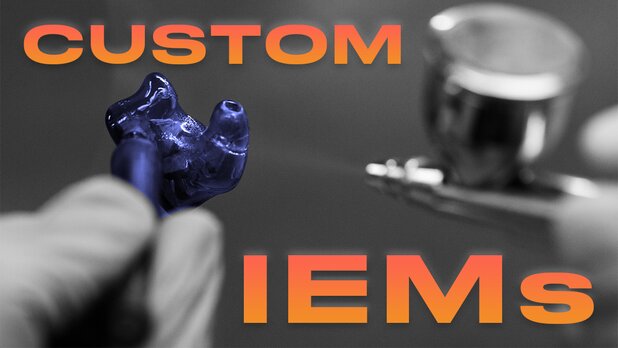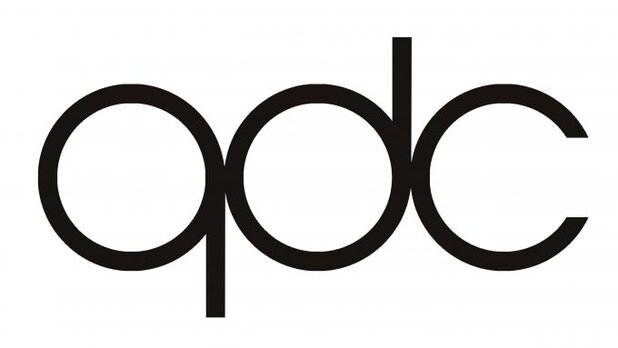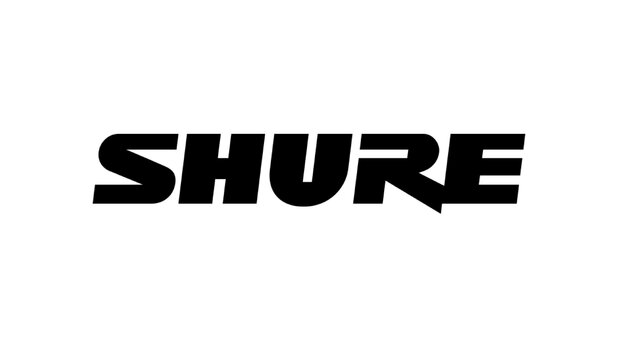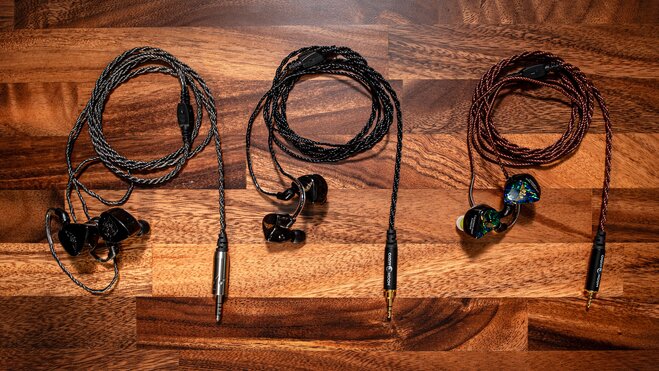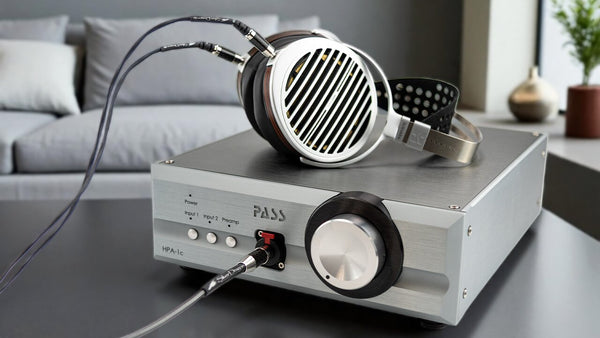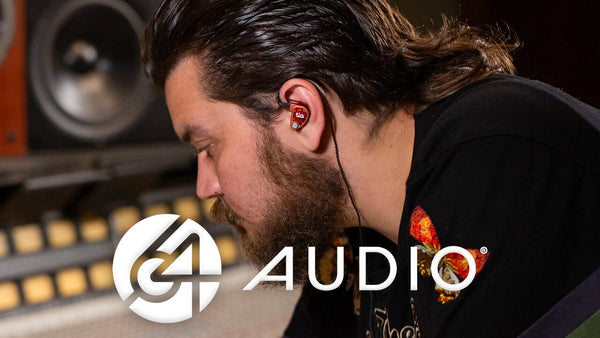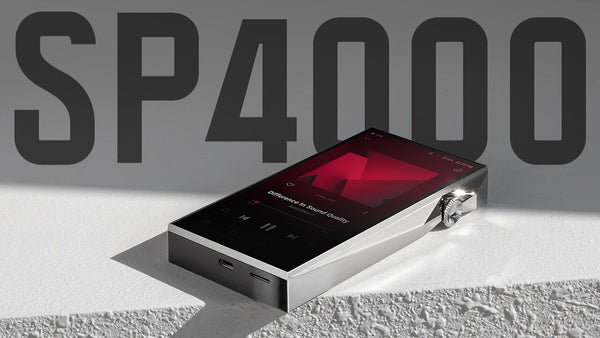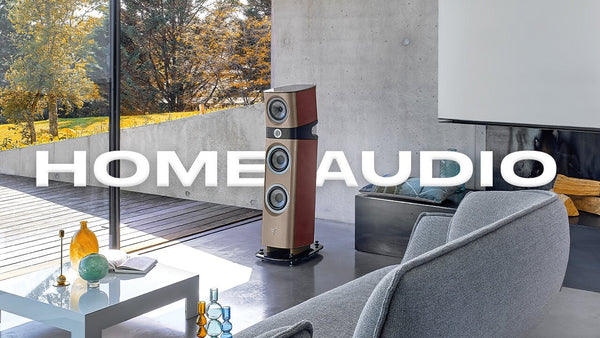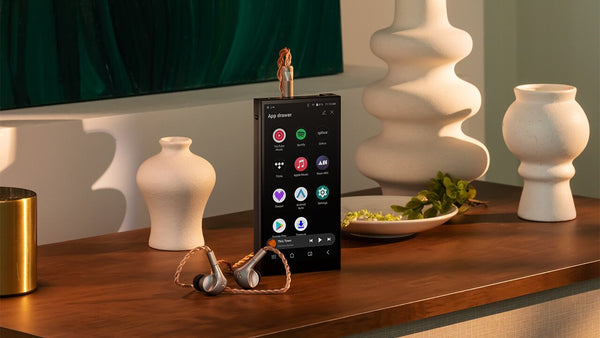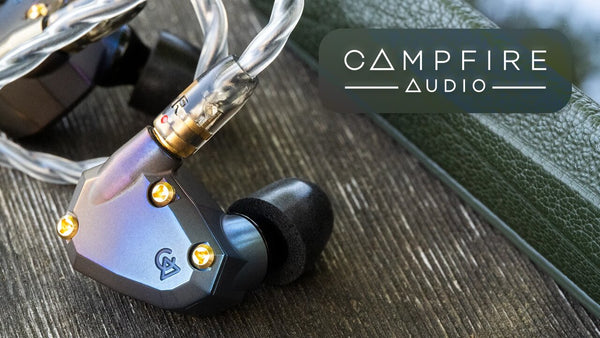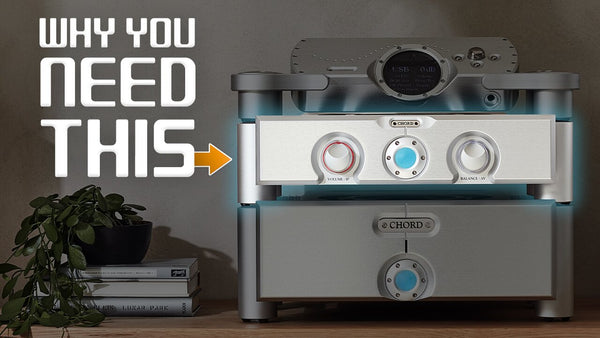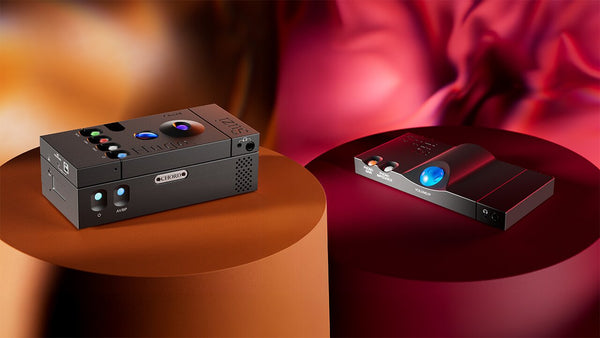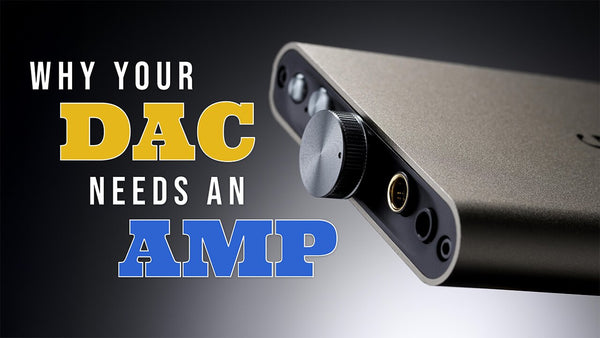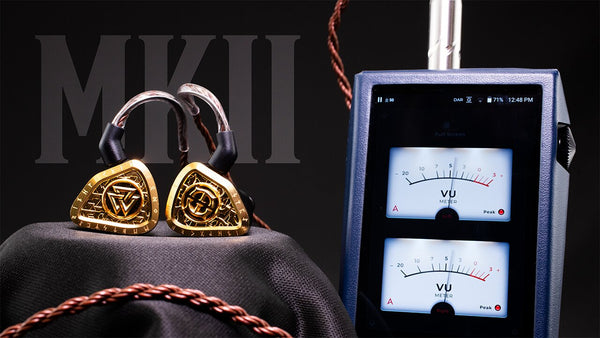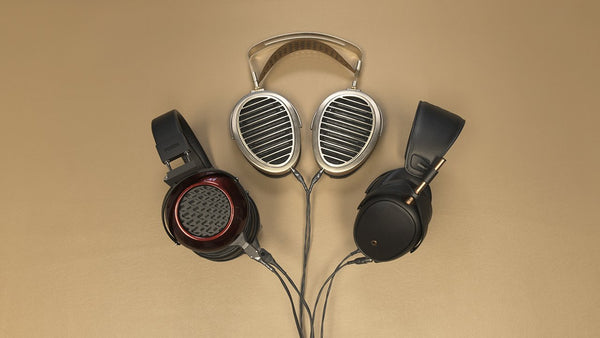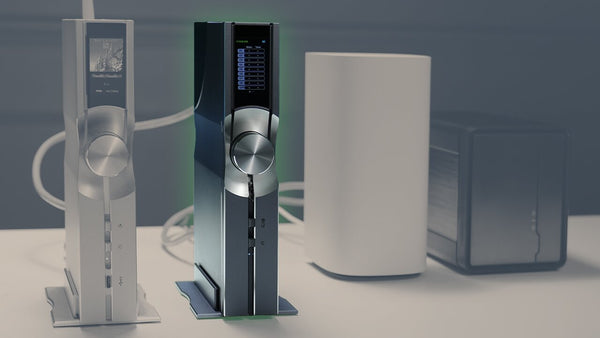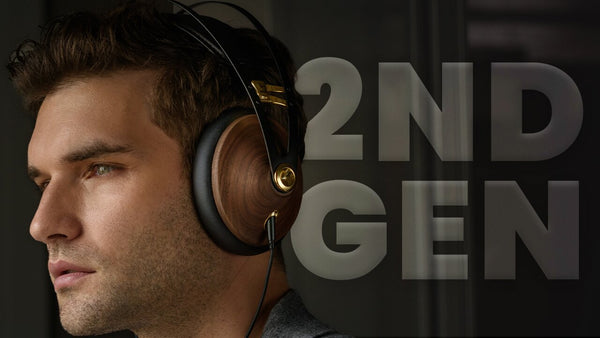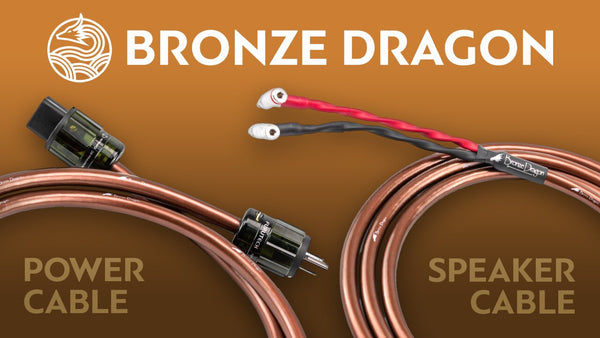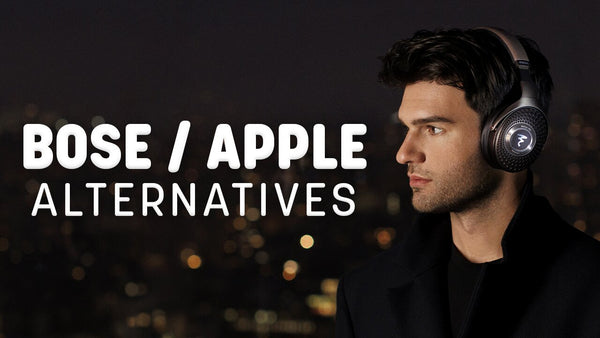IEM Buyers Guide: Universal & Custom In-Ear Monitors

Everything You Need to Know to Find Your Perfect Pair of IEMs
Ask any child whether they want the small wrapped gift or the big one, and they'll undoubtedly choose the big gift. Ask any audiophile or music lover whether they want full-size headphones or IEMs, and the answer isn't as certain. For some people, full-size headphones are a must-have. For others, the smaller option–IEMs–will be the right choice. And many people will choose both!
The audiophile community is full of over-ear headphones but they're not always the most portable, practical option for everyday listening. Thus enters In-Ear Monitors (commonly referred to as IEMs), the earbuds of the audiophile community. While they're not wireless like Apple AirPods, they offer far more in terms of sound quality and technology. And yes, wired earphones/earbuds may seem like a thing of the past, but us audiophiles know that a wired connection is far superior than a wireless. Great for working out, commuting, running errands, and just about every activity in between, IEMs are a great solution for someone seeking a convenient listening option without sacrificing sound quality.
So whether you're a first-time IEM buyer, a seasoned veteran, or just someone curious to learn more, discover the allure of IEMs and why they're one of the most coveted treasures in the audiophile community. Choose from universal and custom fits, multiple driver configurations, and learn why the perfect seal is essential to a great listening experience–all right here.
Why Choose IEMs?
If this is your first time buying IEMs you might be asking yourself "Why would I buy something that costs the same, if not more, than a full-sized pair of headphones but is half the size?" and that's a great question. IEMs aren't going to be everyone's cup of tea but for those seeking a portable, discrete option, they're perfect. No bigger than a silver dollar coin and weighing far less than a pair of full-size cans, IEMs are a convenient way to enjoy music. Because of their small size, they're effortlessly portable and when paired with a hi-fi DAP (Digital Audio Player), or your phone and a portable DAC/headphone amp, your IEMs make for a great on-the-go or home listening solution. When coiled up they'll fit neatly inside of a travel case that's smaller than a wallet. They'll even fit in your pocket (but we wouldn't recommend that).
- Small
- Portable
- Intimate Listening Experience
- Options for Customization
You might not have realized that your favorite singers, guitarists, and musicians have been using IEMs on stage for years. Yep, those aren't earplugs in their ears! They were honestly probably one of the best kept secrets in the music industry up until audiophiles discovered them. Audio engineers use them for live monitoring and studio production (sometimes rivaling the sound of high-quality studio monitors), and they allow musicians to hear themselves and their personal mix while blocking out competing vocals and sounds. As IEMs have become more and more sophisticated (think multiple driver IEMs and advanced technology), they have become more and more popular among audiophiles. Nowadays, IEMs are used by audiophiles, musicians, audio pros, and music lovers alike.
IEMs range in price from budget-friendly models to high-end and the collection of choices is endless. Not to mention they come in two variations, custom and universal, which we'll get right into.

IEMs vs. Earbuds: What's the Difference?
IEMs, earbuds, and earphones–aren't they all the same? To put it simply, no. IEMs and earphones are two phrases used interchangeably in the audiophile community, but they are not the same. At first glance, it's easy to mistake IEMs and earbuds for the same thing, but there are a few clear differences.
1. Fit: Earbuds sit on the outer structure of the ear, while IEMs sit inside of the ear canal
2. Seal/Noise Isolation: IEMs create a seal in the ear, giving a more secure fit and better noise isolation. When you block more sound, you don't have to turn the volume up as high, making IEMs better for hearing preservation. You also get a more immersive listening experience from IEMs vs. earbuds.
3. Driver Configuration/Technology: Earbuds mainly use a single dynamic driver or sometimes a balanced armature driver, while IEMs can use a variety of driver types, either single or multiple, and alone or in combination. IEMs are also going to feature more advanced technologies than most earbuds.
These differences may seem minor, but mistaking one for the other when buying IEMs could lead to a road of disappointment if you intended to buy IEMs. When you think of earbuds, think of Apple AirPods, Beats Solo–the more readily available, consumer-grade earbuds. When you think of IEMs, think JH Audio, Empire Ears, Shure–hi-fi market, audiophile-grade IEMs.

EARBUDS & EARPHONES
- Sit on outside structure of ear
- Typically Wireless
- Single driver configuration
IEMS
- Sit on inside of ear canal
- Better noise isolation
- Dual-driver + configurations; Advanced technologies
The Right IEM for You: Universal vs. Custom
Unlike headphones, which are generally one-size-fits-all, most IEMs come in two fit types–Universal and Custom. Universal-fit IEMs (UIEMs) are the most common type, made to fit a broad range of ear canals. Most people have no problem fitting and wearing universal IEMs comfortably, but it depends on the shape of the IEM and the size of your ear canal. Custom In-Ear Monitors (CIEMs) are one-of-a-kind designed for your ears and yours only. How? Using a custom mold of your ear canal! Most IEM manufacturers make universal IEMs, but there are some brands like Empire Ears and 64 Audio that offer custom IEMs.
Universal IEMs can be a good, ready-to-go option for many listeners. They are designed to fit most ear canals, meaning you can be reasonably sure they will be comfortable for you while providing a good seal. They usually come with ear tips in various sizes so you can find the most secure and comfortable fit. If you don’t want to get ear impressions or wait for custom IEMs to be built, universals are the way to go. Universal IEMs are typically less expensive than custom-fit models too. This is the easiest type of IEM to come by, with almost all manufacturers offering universal-fit IEMs.
Another consideration is degree of noise isolation. If you will be using your IEMs in an office or other environments where you need some awareness of outside sound, universals will provide that because they don't provide as tight a seal as custom-fit IEMs. But if you plan to use IEMs when working out, running, or performing on-stage, you'll want the snugness and security of custom IEMs.
Finally, universal IEMs can be resold to another user. Unless you have a twin—and even then there'd be slim chances your ear canals are the same—there's no way you can resale a pair of custom IEMs.
Custom IEMs
Performing artists and audio professionals who desire maximum fit and better sound isolation usually opt for custom IEMs, but they've grown incredibly popular among audiophiles seeking the utmost comfort and personalization. The list of manufacturers producing custom IEMs is slimmer, but two brands we carry–Empire Ears and 64 Audio–offer custom models. Each pair of custom IEMs is specifically molded for the user's ear canal shape using an impression obtained by an audiologist. Because of the need for a custom impression, custom IEMs are more expensive than universal and take longer to arrive at your doorstep.
One of CIEM's biggest draws is the level of noise isolation a custom-fit delivers. The better noise isolation of custom IEMs means you can listen to them at a lower volume, which helps to protect your hearing. Custom IEMs are also a good choice for use while exercising (running, in particular!) or other activities in which you don't want to worry about an earpiece slipping out. With a CIEM, you get a better seal and a personalized fit with no need for silicone or foam ear tips. You also get a perfect fit for each ear, which is useful if your ear canals are not symmetrical (it's not uncommon).
Custom IEMs also allow you to achieve a particular aesthetic. Empire Ears offers many ways to customize the look of an IEM. Shells and faceplates are available in a variety of opaque and translucent colors. There are also premium and signature designs available for the faceplate, and you can choose from a variety of logos, or even your custom artwork (depending on manufacturer). For those looking for the utmost in fit and comfort, custom fit IEMs are the way to go.
How to Order Custom IEMs
Interested in ordering custom IEMs? Check out the guide to Custom IEMs and place your order today.
Custom IEM in 3 Steps
1. Choose your Custom IEM
We offer custom IEMs from the renowned IEM manufacturers Empire Ears and 64 Audio. Selecting which custom IEM you'd like is no different than picking a universal IEM. You want to pick the IEM that delivers your desired sound.
When you have chosen the IEMs you like, go ahead and place your order at moon-audio.com. After that, you will need to obtain your impressions.
2. Get an Ear Impression
After you've placed your order, it's time to obtain your impressions. Please follow an IEM impression guide to ensure the best possible fit for your custom IEMs. Remember that your ear impressions will dictate the final fit of your custom IEMs.
- Find an Audiologist in your area (Googling an audiologist in your city will provide a list). Make sure you find an audiologist familiar with how to make a "full shell impression including the crus of helix, tragus, and anti-tragus"— that's audiologist speak, they will understand. Molds should cost anywhere from $50 to $150 depending on where you live.
- Once you've received your molds, email impression photos to sales@moon-audio.com for approval. Take a few photos of your impressions with your phone on a solid color surface and background. Please make sure there is adequate light to provide us with the most detail possible. Please include your full name and allow us 24 hours to review your impressions.
- After you've received approval for your molds via email, it's time to mail your impressions to Moon Audio. Complete this form with your name, order number, email, phone, and address and mail it with your impressions to:
Moon Audio
1157 Executive Cir. Suite 101
Cary, NC 27511
3. Await a Music Experience Like No Other
It normally takes 4-6 weeks for you to receive your custom IEMs, but trust us, it's worth the wait. When you order your custom IEMs from Moon Audio, you can also choose to upgrade the stock IEM cable to one of our Dragon Audio Cables.
The Importance of Proper IEM Fit
Fit is essential to the perfect IEM listening experience. If one or both earpieces (nozzle with ear tips attached) do not fit snugly enough, they may slip, forcing you to reach up and readjust. There is also the issue of comfort, as an improper fit just won't feel good in or on your ear. No one wants to spend their hard-earned money on a new pair of IEMs just to find out they're so uncomfortable they'll never wear them. To ensure you are getting the best fit from your IEMs, make sure you are inserting them properly. With universal IEMs, be sure to secure the tip onto each earpiece. If using Final Audio Type E tips, squeeze them before insertion.
The other major consideration is sound quality. Without the proper seal, you won't reap the full sonic benefits of your IEMs and what's supposed to sound great might end up sounding horrible. You'll be asking yourself "Why do these $1,500 IEMs sound like $20 earbuds?" If your IEM earpieces are not properly positioned within your outer ear canal, your audio will sound sub-par with lower volume and diminish the low-end response. There will also be less noise isolation. To help ensure this doesn't happen, you may need to experiment with ear tip styles and sizes. Silicone and foam ear tips are the top two ear tip types and most often your IEMs will come with silicone tips in up to 5 sizes (SS, S, M, L, XL).
To Insert Your IEMs
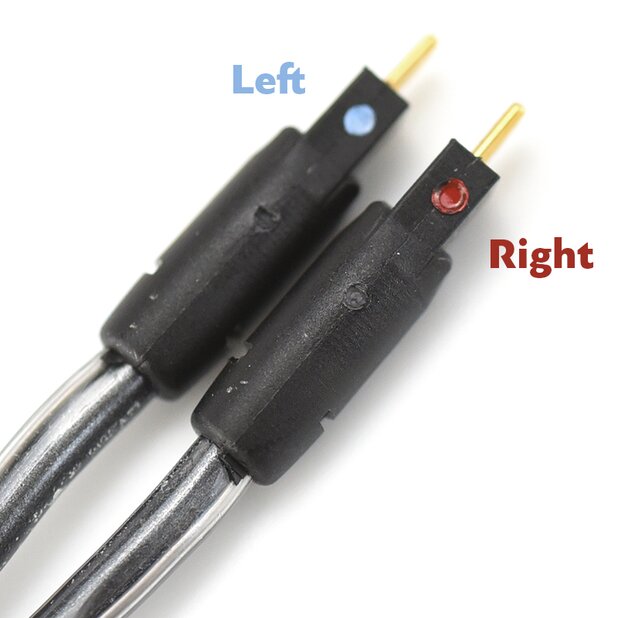
1. Match the correct IEM with each ear (you'll find a color indicator or L/R symbol for the left or right IEM)

2. With each earpiece (nozzle) resting loosely at the base of your ear canal, turn the IEM forward, then gently insert it into your ear canal.
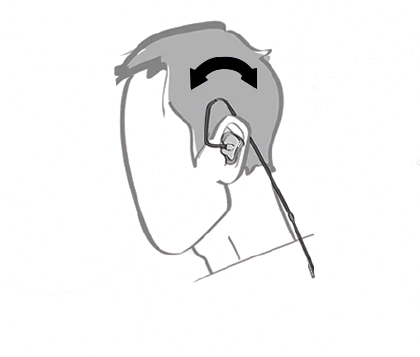
3. Gently rock it back and forth, until completely snug in the ear
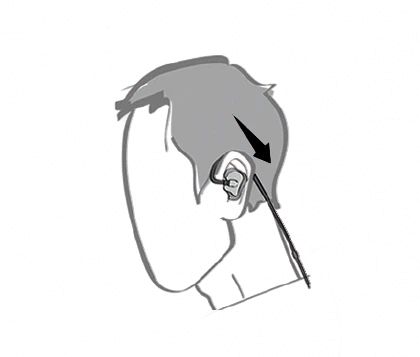
4. With the cable facing in an upward direction, secure it behind the ear by pulling it up and over the top of your ear

5. Cinch the IEM cable for the best isolation
Tips
- You may hear a slight 'pop' or suction sound indicating you've achieved the proper seal. This does not happen with every IEM, it is completely normal and is a phenomenon found most with dynamic driver IEMs.
- If the IEM is not snug, falling out, or too big for your ear canal, switch out ear tip sizes (sizing down for too big and up for too small). Try different ear tip types if you still cannot achieve a proper seal.
- Gently wiggle your ear lobe and/or slightly open your mouth to expand your ear canal ever so slightly to achieve a snug fit.
Attaching and Detaching Your IEM Cable
1. Attach: Match the correct IEM with the right cable. The cable and IEM will have a color indicator or L/R to denote which
2. With the top of the connector facing upward, insert the IEM cable by sliding it into the socket of the IEM until it feels snug. There may be a colored dot or arrow on the cable indicating the top of the connector. This indicates that the positive and negative are inserted correctly.
3. Detach: Grasp the base of the cable by its port and gently pull outward while wiggling back and forth ever so slightly. DO NOT attempt to remove by puling the cable or you might damage the cable port and IEM.
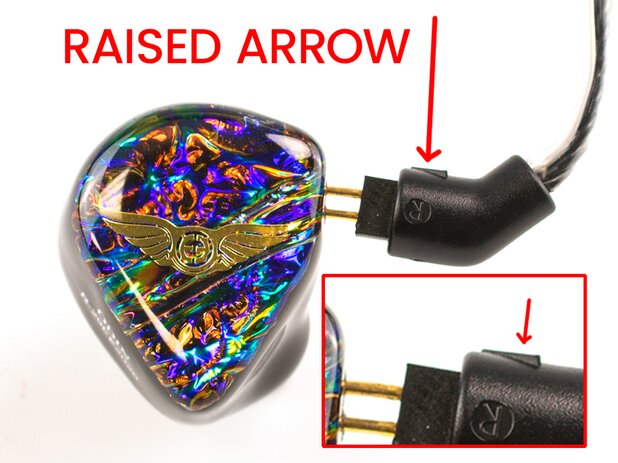
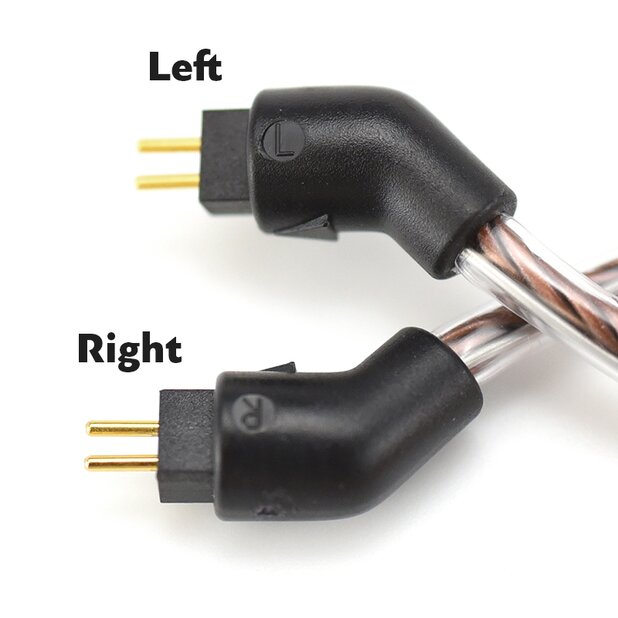
Caring For Your IEMs
Have you ever taken out your earbuds only to discover your ears weren't as clean as you thought? We've all been there and the funny thing about ears is that no matter how often you clean your ears, there's always a tiny bit of earwax that somehow gets missed. Well, your IEMs are like magnets for the tiny dirt and grime that lurks in the crevices of your ears and if you're not careful you can wind up with a mound of build-up damaging your IEMs tech and performance. This is not covered under warranty. You'll want to routinely clean your IEMs–ideally after every use–so you can mitigate that buildup and prevent any damage to your precious in-ear monitors.
Most IEMs come with an included carrying case (usually hardshell) for storage and protection, several ear tips, and a stock cable. Occasionally, you'll find accessories like a cleaning tool and microfiber cloth. In the cases where you're buying your IEMs secondhand or you don't get all the additional swag, here are our recommendations for IEM care.
Caring for your IEMs also means proper connection and disconnection of your IEM cables. MMCX connections can be difficult to handle and our MMCX tool, included with every purchase of an MMCX Dragon IEM Cable helps you disconnect your IEMs safely without harm.
DO
- Clean the exterior, interior, and underside of ear tips with alcohol wipes
- Use a microfiber cloth to polish the shell
- Use the brush end of a cleaning tool to eliminate any debris on the surface of your IEMs
- Use a cable removal tool to properly detach the cable. If you do not have a removal tool, grasp the base of the cable where it meets the IEM and gently pull the attached connector
- Coil up the cable using the over-under method, following the natural shape the cable bends
- ALWAYS store IEMs in a carrying case
DO NOT
- Clean your IEMs with the cable and ear tips attached
- Use abrasive cleaning agents to polish the shell
- Scrub the IEM nozzle using brut force
- Expose your IEMs to moisture
- Remove your IEMs by pulling on the cable
- Wear an IEM if it has microfractures, as it can break during use
- Allow the IEM to hit hard surfaces or knock into each other
The Anatomy of an IEM
Like headphones, IEMs come in all shapes and sizes. Some manufacturers, like Empire Ears and 64 Audio have a signature look, with the only thing changing between launches being the faceplate color. Others "break the mold" sort of speak and create less traditional, more unconventional-shaped IEMs. But shape is just one aspect of an IEM's anatomy. You've also got all of the technology inside of IEM that impacts its sound quality and listening experience. Let's dive into the anatomy of an IEM so you can make the most informed buying decision on your IEM journey.

Shell
The Shell is the outermost part of the IEM. It can also be referred to as housing. It's the protective housing of the IEM that contains the IEM drivers and additional tech. Shells can range in size from the smaller size of the Sennheiser IE600 IEMs to the larger size of the Empire Ears RAVEN IEMs. But bigger doesn't necessarily mean heavier—it depends on the number of drivers inside as well as the material of the earphones, which may be made from metal, plastic, acrylic, resin, or a combination.
Nozzle and Ear Tips
The part of the IEM that sits in your ear canal is called the Nozzle. Nozzles vary in length depending on the IEM. If you're using universal IEMs, the nozzle is what the ear tips attach to. Ear tips come in a variety of materials and sizes to help you achieve the optimal fit and sound. You don't have to limit yourself to the ear tips that come with your IEMs and it's worth exploring your options if you haven't found the perfect tip. The two most widely used options are silicone and foam. Silicone is the most universal ear tip type that's easy to clean and durable. Foam ear tips mold to your ears more and provide better noise isolation than silicone.
Silicone
Easy to clean
Minimal noise isolation
Durable
Single, double, and tripe-flange styles
Foam
Molds to ear canal for a secure, comfortable fit
Extreme noise isolation
Not as durable
Available in different shapes
Drivers
The Driver(s) is the heart of your IEMs. Think of an IEM driver as a miniature speaker inside the IEMs that converts electrical signals into audible sound waves that are then pushed or "driven" into your ears. Driver count depends on the IEM. Some IEMs feature one driver while others can feature as many as 11 in a pair of IEMs. If an IEM is a single-driver IEM there will be one driver per side. The Sennheiser IE 600 IEMs are single-driver IEMs. On the other hand, the Empire Ears Legend EVO IEMs use eight IEMs. Does more equal better? Not necessarily. A single-driver IEM can sound every bit as good as one with multiple drivers. There are so many factors that are going to determine the sound of your IEMs, and the number of drivers in and of itself is not going to tell you.
Alongside driver count is driver type. IEMs can feature multiple of the same driver or several different driver types. Each IEM driver type possesses unique sonic characteristics that impact the sound quality of the IEMs. A combination of more than one IEM driver type will result in a sound different from an IEM featuring only one driver type. Understanding the types of drivers will help you determine the sound you're looking for in your IEMs.
Dynamic Driver
Dynamic drivers are tiny versions of the woofers used in speakers. Dynamic drivers have a diaphragm 8mm to 11mm in diameter, connected to a coil of wire around a magnet. When an electrical signal moves through the coil, a magnetic field is created, moving the diaphragm. Dynamic drivers are the least expensive driver type and are known for their bass response. The Shure SE215 IEM is an example of a single, dynamic driver IEM. They're incredibly common in full-size headphones and featured in a lot of multi-driver IEMs.
Balanced Armature Driver
Balanced Armatures are very small, so as many as a dozen can be packed into an IEM. Typically, separate balanced armatures are used for the treble, midrange, and bass. Multiple drivers may be used for a single frequency. A crossover circuit, like those found in speakers, divides the signal into bass, midrange, and treble. Balanced Armature drivers are known for detail and accuracy, but have a less impactful bass.
Electrostatic Driver
Electrostatic drivers resemble planar magnetic drivers; the difference is the diaphragm. Electrostatic drivers have a layer of conductive material carrying a bias voltage. The two magnetic plates surrounding the diaphragm carry the audio signal. Electrostatic drivers are known for clear, spacious, detailed sound, low distortion, and treble extension.
Hybrid, Tribrid & Quadbrid IEMs
Some manufacturers make hybrid IEMs that use balanced armatures for the middle and upper frequencies and dynamic drivers for the lower frequencies. They also make IEMs that use three or more driver types to achieve various sound characteristics.
Hybrid IEMs
An example of a hybrid IEM, the Empire Ears Wraith combines seven balanced armatures and four electrostatic drivers.
Tribrid IEMs
Some IEMs combine three driver types. The Empire Ears Odin, for example, uses two dynamic, five balanced armature, and four electrostatic drivers. That's 11 drivers per side!
Quadbrid IEMs
Four driver types in one IEM? The Raven from Empire Ears combines 5 balanced armatures, 4 electrostatic tweeters, dual W9+ subwoofers, and one W10 bone conduction ultra driver in a quadbrid design. A multi-point synX crossover network is used to harmonize all of the drivers.
Buying IEMs: The Best In-Ear Monitors at Every Price Point
Moon Audio sells IEMs from several respected high-fidelity audio brands. Empire Ears exclusively makes IEMs, while other companies like Sennheiser and Meze Audio include IEMs as part of their product offerings. Like anything else, IEMs are available at a variety of price points, from pricier reference models to comparatively more budget-friendly options. But you don't have to spend a fortune on a high-quality pair of IEMs. Certainly, the more expensive the better materials and fancier technologies, but that doesn't mean there aren't phenomenal options lower down. It all comes down to sound quality. When you find a pair of IEMs that sound amazing to you, then you have your perfect match.
We offer universal and custom IEMs from 64 Audio, Astell&Kern, Empire Ears, Meze Audio, QDC, Sennheiser, and Shure. If you are interested in purchasing a custom IEM from Empire Ears or 64 Audio please reach out to us directly and we can assist you in the buying process. Additionally, we offer several earbuds and earphones from Fostex, Sennheiser, and Sony that are more affordable which we'll include in the roundup.
Entry-Level: < $1,000
Meze Audio Alba In-Ear Monitors
Sound Signature: Neutral, Warm-leaning
Meze Audio's newest IEM the Alba is perfect for everyday listening in any scenario. The Alba vividly emphasizes every aspect of your favorite songs with a neutral, warm-leaning sound signature. Built with daily listening in mind, the Alba is extremely comfortable with an ergonomic shape that nestles comfortably in your ear and provides excellent noise isolation. As a single dynamic driver IEM, the Alba is easy to use and can be driven by your smartphone using the 3.5mm to USB-C adapter cable. This specially-made adapter features a built-in DAC/Amp combo to ensure an immersive listening experience. The adapter also features an LED indicator that turns on when properly connected. Designed for those who dance to their own beat, for the curious and the free-spirited, the Alba IEM comprises a perfectly accessible and qualitative introduction into the world of elevated audio enjoyment.
Enhance the Alba's sound with the Bronze Dragon IEM Cable (MMCX). The Bronze Dragon will add musicality and additional warmth to the Alba for a well-rounded listening experience.
Sennheiser IE600 Earphones
Sound Signature: Clear, Natural, Engaging
The Sennheiser IE 600 is a great option for audiophiles who want an IEM with a small footprint and a natural, detailed sound. The IE 600 is not as neutral or detailed as the flagship IE 900, but it's pretty good on both of those counts. The sound is relatively intimate, as you'd expect with an IEM, but the IE 600 still does a pretty good job with imaging and keeping various instruments and vocals in their respective places. While appropriate for a variety of music styles, the IE 600 works especially well with vocals, acoustic music, folk, blues, and Americana — anything that calls out for a natural yet expressive presentation.
The Sennheiser IE 600 IEM is an excellent option if you're looking for detail retrieval. There's some lovely sparkle on the top end that provides some excitement to the listening experience, and these are a delight for soundtracks as well. The IE 600 is on the small size as far as IEM chassis go, and that's great for people with smaller ears and canals.
The Bronze Dragon IEM cable will provide some additional warmth to an otherwise analytical IEM, adding meat to the sound for gaming and music at a price point more in line with a serious music lover.
Campfire Audio Clara Hybrid Universal IEMs
Sound Signature: Neutral, musical, refined
Experience the sonic precision of the Campfire Audio Clara IEMs, a professional in-ear monitor developed in close collaboration with renowned musician, Alessandro Cortini. With a hybrid driver configuration, the Clara Hybrid Universal IEM delivers a musical and refined listening experience with exceptional acoustics and no glaring issues. Fusing tried and true IEM technology with new innovations, the Clara earphone presents a refreshing new experience for audio professionals and music lovers alike.
Shure SE846 Pro Gen 2 Sound Isolating Earphones
Sound Signature: Versatile (Extended, Warm, Balanced, or Bright)
The Shure SE846 Pro Gen 2 IEM is built for the audiophile demanding an immersive listening experience. Four custom-engineered drivers tailored to blend precisely with each other deliver extended high-end clarity, while the groundbreaking low-pass filter design gives you the performance of a true subwoofer — all without sacrificing a solitary detail. Customize your audio even further with a selection of four unique sound signatures, including a new "extended" option.
The detachable cable enables the ability to convert to wireless or integrate other wired accessory options, and a comprehensive sleeve assortment provides a perfect fit. Sophisticated listening for the refined ear, the SE846 Pro Gen 2 is an incredibly versatile IEM that will grow with you as your music tastes evolve.
Campfire Audio Cascara IEMs
Sound Signature: Energetic and Engaging
The Cascara IEMs from Campfire Audio offer a listening experience like no other. Experience acoustic intricacies and live performance energy through a meticulously crafted full-range dynamic driver. Elevate your listening to an immersive, emotional experience. As a universal-fit IEM, the Cascara IEMs are the perfect grab-and-go pair for everyday listening. Whether you're hitting the gym or just hanging out at the house, the energetic and engaging sound of the Cascara combined with a nice snug fit and comfort, you'll be immersed in a next-level listening experience.
$1,000 to $2,000
Campfire Audio Fathom Balanced Armature Universal IEMs
Sound Signature: Warm and Musical
The perfect IEM for warm and musical listeners, the Fathom IEMs by Campfire Audio delivers just enough warmth that elevates vocal performance and offers a glowing musical experience. Utilizing a new dual mid-driver assembly, Fathom creates astounding richness, texture, and elevation to vocal performance, sharing every emotive detail from the artist to the listener. Paired with custom dual low and high balanced armature, Fathom offers top-to-bottom precision, detail, and resolution. Dive into the sonic depths of the Fathom IEM and enjoy incredible balance, soundstage, resolution, and detail.
Sennheiser IE900 Earphones
Sound Signature: Clean, Balanced, Detailed
You know you've found a keeper of a headphone or IEM when you want to keep on listening to every single piece of music you know and love. This was our experience with the IE 900 from Sennheiser: a pleasure to listen to and super comfortable to boot. A nice, full sound that sounds natural and clear -- great with blues, folk, acoustic strings, and music with lots of detail. Vocals are super clear and emotive. Treble on the IE 900 is definitely something to write home about. Lots of sparkle. Piano on several tracks sounded absolutely gorgeous. If you're deciding between the IE 600 and the IE 900, choose the IE 600 if you want a more fun sound for on-the-go listening/gaming, the IE 900 if you are all about detail and clarity and are not willing to compromise. You won't be disappointed. Of course, cost plays into it, but ultimately with Sennheiser, you get what you pay for. Be sure to add in the Bronze Dragon IEM Cable for Sennheiser for additional warmth and musicality - you'll really feel the motive properties of the IEM.
Even though the IE600 and the IE900 might look the same, there is a substantial difference between the two sonically. You'll find a more refined sound, resolution, and slightly better imaging in the IE900. Sennheiser is known for its clarity, and the IE900 is one of our top picks for competitive gaming. The chassis is on the small side, making it super comfortable for longer gaming and listening sessions. The soundstage on the IE 900 is intimate, with layers of sound and everything clearly delineated. This is great for both immersive and competitive gaming, and we can't recommend the IE 900 IEMs enough for any gamer out there.
64 Audio U6t In-Ear Monitors
Sound Signature: Balanced, Natural
One of 64 Audio's entry-level IEMs, the U6t IEM is perfect for audiophiles craving a balanced, natural-sounding In-Ear Monitor. The U6t is slightly set apart from the other 64 Audio UIEM models by offering a softer presentation of a mix. Beautiful upper-mid imaging, realistically presenting instruments like guitars and piano as well as breathing life into saturated mid-bass mixes, especially when vocal-focused. Using the various included apex modules and ear tips allows the listener to further customize the sound of the U6t based on the needs of the music.
The U6t is equipped with 64 Audio's tia, apex, and LID technology, contributing to the overall stellar performance of these IEMs. Tia reduces unwanted resonance and distortion for a transparent and lifelike sound signature while the Apex vent releases air pressure so you can enjoy a fatigue-free listening experience. LID restores proper interaction with your source device, preserving the desired sound signature for a reliable, consistent sound. Pair the U6t with your favorite DAP, DAC/Amp, or smartphone and start listening on the go.
When paired with the Bronze Dragon IEM Cable, the U6t IEM has more musicality and warmth. The Bronze Dragon is our warm and musical-sounding IEM Cable, delivering a fuller, balanced sound with the perfect balance of warmth and detail.
QDC 8SS Universal IEM
Sound Signature: Accurate, Balanced, Smooth
Specially designed for recording engineers and discerning audiophiles, the QDC 8SS IEM features 8 micro-balanced armatures, 4-way sound channels, and a 4-way crossover circuit. The 8SS IEM fits all music styles with an accurate, balanced, and smooth sound signature. Compared to any other brands, the middle-high frequency details of QDC monitor increase multiply, low middle and high frequency present decorous, clear, and sweet with no superfluous embellishing to sound, perfectly reflecting all the details of sound, fully releasing the tone quality and whole sound effect, which brings a superlative clear hearing feast. The monitor’s superior frequency response, low distortion, and incomparable resolution can restore every sound detail, and provide the professional accurate criterion.
The QDC 8SS IEM also offers optional customized appearance, personalized design patterns, characters, and color can also be customized for the external faceplate. QDC monitors have been calibrated by top sound engineers and professional musicians to provide the best possible sound quality.
Paired with the Black Dragon IEM Cable that comes standard, the QDC 8SS delivers a listening experience that will leave you energized and smiling.
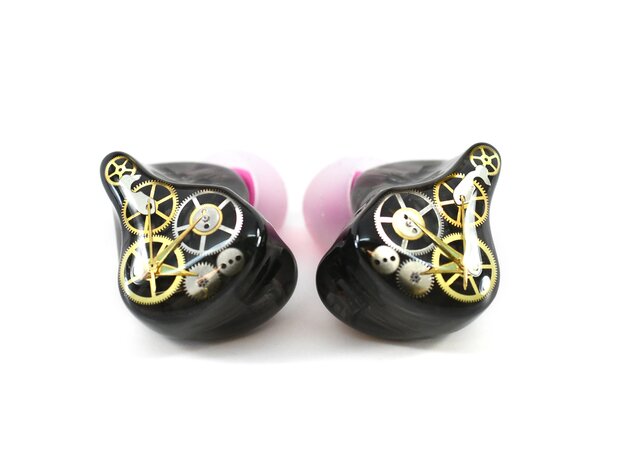
QDC 8SH Universal IEM
Sound Signature: Detailed, Fun, Lively
Enjoy an energetic and engaging listening experience with the QDC 8SH Universal IEM. These tiny in-ear monitors deliver a fun sound with great vocals, making them perfect for the catchy melodies of pop music. The 8SH is a good-time IEM with great technical chops. Sometimes you want a fun, lively sound but you don't want to sacrifice the things that your audiophile ears appreciate like detail retrieval, clarity, and instrument separation. The 8SH has an aggressive sound that never comes across as overwhelming or muddy. Treble is smooth and vocals are on the forward side. Bass is clear and stays in its lane.
Paired with the Black Dragon IEM Cable that comes standard, the QDC 8SH delivers a listening experience that will leave you energized and smiling.
64 Audio Nio In-Ear Monitors
Sound Signature: Natural Warmth, Smooth
64 Audio's first high driver-count hybrid IEM, the Nio IEM features a 9mm dynamic driver and 8 balanced armature drivers for an exceptional listening experience. With a sound signature characterized by extended lows and a rich 3-dimensional soundstage, Nio’s smooth treble and natural warmth will provide hours of enjoyable listening for all genres of music. With the included variety of tips and apex modules you can take Nio from a saturated tube-like warmth all the way to a neutral reference monitor tonality.
Similar to some of 64 Audio's other unique faceplates, the Nio IEM is finished with a naturally sourced striking blue abalone faceplate making each pair truly unique. Incorporated into the Nio IEM are 64 Audio's tia technology, Apex, and LID circuit. Tia reduces unwanted resonance and distortion for a transparent and lifelike sound signature while the Apex vent releases air pressure so you can enjoy a fatigue-free listening experience. LID restores proper interaction with your source device, preserving the desired sound signature for a reliable, consistent sound. Pair the Nio with your favorite DAP, DAC/Amp, or smartphone and start listening on the go.
The Silver Dragon IEM Cable will add detail, clarity, and top-end resolution to the Nio IEMs. The Silver Dragon is our top-of-the-line flagship audio cable, using UP-OCC silver conductors to deliver a clear, articulate listening experience.
Empire Ears Triton In-Ear Monitors
Sound Signature: Warm side of Neutral
Introducing Empire Ears' latest IEM innovation, the Triton IEM. The Triton IEM represents Empire Ears legacy of precision and innovation, embodying the company's relentless pursuit of extraordinary sound and celebration of a decade in business. This marvel seamlessly blends classic Empire Ears craftsmanship with an all-new tribrid, dual conduction architecture. The Triton features Empire Ears' signature W9+ subwoofer, precision-engineered EMP75 balanced armature, and next-generation dual high-mass bone conductors. These three technologies combined provide a rich, immersive, and distinctly bold Empire Ears sound that has defined the industry over the past decade and continues to set new standards.
For an elevated listening experience, we recommend pairing the Empire Ears Triton IEM with our Dragon IEM Cables. The Silver Dragon IEM Cable is our top-of-the-line flagship audio cable, using UP-OCC silver conductors to deliver a clear, articulate listening experience. It's designed to maximize the amount of detail, clarity, air, and instrument separation you get from your IEMs. It's a smooth and clean-sounding cable that will balance warm or dark-sounding IEMs. The Black Dragon IEM Cable boosts detail while adding bottom-end weight to your IEMs. This silver-plated copper cable will increase clarity and resolution while providing a bump in warmth and fullness. It's a wonderful match for IEMs with a V-shaped sound. The Bronze Dragon IEM Cable is our warm and musical-sounding IEM Cable, delivering a fuller, balanced sound with the perfect balance of warmth and detail. The Bronze Dragon uses UP-OCC copper conductors to warm, expand, and strengthen the bottom end for an improved presentation of any thin or bright-sounding IEMs.
64 Audio U12t In-Ear Monitors
Sound Signature: Detailed, Articulate, Engaging
Praised for its technical performance, detail retrieval, and versatility across genres, the 64 Audio U12t IEMs are a popular choice among music lovers and audiophiles for portable audio bliss. A universal in-ear monitor with an impressive 12 drivers, the U12t is an articulate IEM with a beautifully warm and engaging low-end response. The U12t does it all, taking its design and sound impressions from the custom variant, the A12t IEM. The U12t incorporates several 64 Audio proprietary technologies, including the tia (Tubeless In-Ear Audio) system, apex (Air Pressure Exchange) technology, and LID (Linear Impedance Design) for a reference-level sound that's highly regarded and sought after in the audiophile community. If you want an IEM that can do it all, no matter the genre you throw at it, consider the 64 Audio U12t IEM.
The U12t IEMs retain 64 Audio's iconic styling and design seen across their universal product line. With an ergonomic shell machined out of solid aluminum and finished with a brushed aluminum faceplate, the U12t's durable build quality is perfect for everyday use.
We recommend pairing the 64 Audio U12t IEMs with our Silver Dragon IEM Cable. Constructed of UP-OCC Silver, our Silver Dragon IEM Cable is designed to maximize the amount of detail, clarity, air, and instrument separation you get from your listening experience. It'll add detail and resolution, and tighten up the low end of the U12t.
Reference
64 Audio Volür In-Ear Monitors
Sound Signature: Emotive, Engaging, Rich
Ushering in a new era of technological innovation, the 64 Audio Volür is a 10-driver hybrid Universal In-Ear Monitor, building on the heritage of the 64 Audio Nio IEM. Sporting two new innovations from 64 Audio, the Volür is made up of two custom 9mm dynamic drivers in a True Isobaric configuration as well as incorporating the Tia waveguide technology. Along with the already industry-defining, patented tech like Apex, Tia, and LID, the Volür IEM takes its place among the most resolving high-end audio products in the world. If you're ready for a new benchmark in IEM performance, check out the Volür IEMs and begin reaping the sonic difference.
The Volür IEM delivers an engaging, emotive sound that will have you tapping your toes and immersed in the vocals of your favorite artists. With 64 Audio's Apex modules included, listeners can enhance the Volür's sound even further. The m15 stock module is the most demanding of the four modules with an incredible bass response that's boosted, big, and bold. The m12 module takes the bass down a notch, delivering a faster, punchier bass that's not overly impactful. If you want a little more headroom without compromising on the level of noise isolation, the m20 module delivers just that. From the innovative technology to its striking design, and incredible sound quality, the Volür is the Swiss army knife of IEMs worthy of flagship status.
We recommend pairing the Volür IEMs with our Bronze Dragon IEM Cable and Silver Dragon IEM Cable. The Bronze Dragon is our warm and musical-sounding IEM Cable, delivering a fuller, balanced sound with the perfect balance of warmth and detail. The Silver Dragon is our top-of-the-line flagship audio cable, using UP-OCC silver conductors to deliver a clear, articulate listening experience.
Shure KSE1500 Electrostatic Earphones
Sound Signature: Natural, Balanced
The Shure KSE1500 IEM is an all-in-one system equipped with a rechargeable USB amplifier with digital-to-analog conversion and support for both digital, streaming, and pure analog audio sources–portable or otherwise. The Shure KSE1500 is the first ever single-driver electrostatic sound isolating earphone. The design features a virtually weightless, massless diaphragm, surrounded by an electrostatic field generated by back plates that manage charge oscillation.
The audio technology of the KSE1500 earphones enable listeners to fine-tune and appreciate frequencies that may be distorted, or lost completely. Extremely high correlation to the source audio provides unmatched audio clarity and detail. Custom-designed Kevlar™ reinforced cable specifically isolates each conductor. Sound Isolating™, comfortable sleeves block up to 37 dB of ambient noise. Lightweight, ergonomic shape minimizes ear fatigue.
Empire Ears Legend EVO Universal IEMs
Sound Signature: Bassy, Energetic
Like the Legend X, the Empire Ears Legend EVO IEM has a huge, powerful sound, with a masterful and copious low end that will please even the most die-hard bass fanatic. The thing that makes the Legend EVO stand out from other IEMs, including its predecessor Legend X, is the visceral quality of the sound, and the way you experience it both inside and outside of your body. But the Legend EVO has a big soundstage that allows all instruments to claim their space rather than being drowned out by the bass. With a dual-conduction architecture and eight-driver tribrid system, the Legend EVO emits unprecedented levels of innovation and performance to create a new benchmark in the IEM industry.
We recommend pairing the Empire Ears Legend EVO IEMs with the Silver Dragon IEM Cable. The Silver Dragon is our top-of-the-line flagship audio cable with silver strands clarifying instrument separation, increasing the soundstage, and finding previously lost high and mid-frequency sounds. The detail and clarity of the Silver Dragon IEM Cable will tame the bassy and energetic sound of the Legend EVO for a pleasant listening experience.
Empire Ears Wraith Universal IEMs
Sound Signature: Dark side of Neutral
The Empire Ears Wraith Universal IEM is the world's first quad electrostatic IEM featuring Empire's EIVEC (Empire Intelligent Variable Electrostatic Control) technology. Seven balanced armature drivers, two transformers, and four electrostatic drivers combine to provide world-leading treble extension, rich and precise mids, and an earthy, tight low end. In the Wraith, EIVEC uses two transformers to bring the quadruple Electrostatic drivers into order, dividing the duties of the EST drivers and blending them seamlessly with the seven balanced armature drivers which fill out the rest of the robust sound profile. The result is an enormous soundstage in which no detail is overlooked. It's like sitting alone in an auditorium in front of your own personal orchestra. You'll hear music like never before with great clarity, texture, and detail.
We recommend pairing the Empire Ears Wraith IEMs (universal and custom) with the Silver Dragon IEM Cable. The Silver Dragon is our top-of-the-line flagship audio cable with silver strands clarifying instrument separation, increasing the soundstage, and finding previously lost high and mid-frequency sounds. The detail and clarity of the Silver Dragon IEM Cable make it a perfect match for individuals using the Wraith for studio monitoring and technical listening.
Campfire Audio Trifecta Triple Dynamic Driver Universal IEMs
Sound Signature: Dynamic, Rich
If you're looking for a reference-level pair of unique IEMs, it's our pleasure to introduce the Trifecta IEMs from Campfire Audio. As Campfire's first and only IEM to feature three, full range 10mm dynamic drivers, the Trifecta delivers an expansive soundstage and vivid sound quality. This feat allows the Trifecta to move a significant amount of air, creating a signal that is powerful enough to conjure an over-ear like experience in the compact, personal, and portable form-factor of an IEM. With effortless connectivity, sonic craftsmanship and a natural and lifelike sound, the Trifecta IEMs allow you to enjoy your music just the way the artist intended.
Empire Ears ODIN Universal IEMs (& Custom Variant)
Sound Signature: Neutral, Balanced
For mortals who seek a listening experience that is nothing short of godly, the Empire Ears ODIN IEM brings the best of everything Empire has done to the table: the three best IEM driver technologies available, with the most advanced crossover system in the industry, the finest quality materials, and masterful tuning. The ODIN is grand and enthusiastic but controlled, with a totally natural signature and clarity that rivals the ESR MKII without being overly analytical. In the words of Empire co-founder Jack Vang, the ODIN is the very personification of Empire's DNA at its most extreme -- in design, performance, and breadth of capabilities.
We recommend pairing the Empire Ears ODIN IEM with the Silver Dragon IEM Cable. The Silver Dragon is our top-of-the-line flagship audio cable with silver strands clarifying instrument separation, increasing the soundstage, and finding previously lost high and mid-frequency sounds. The detail and clarity of the Silver Dragon IEM Cable will accentuate the performance of the ODIN IEMs for an enjoyable listening experience.
Empire Ears RAVEN Universal IEMs
Sound Signature: Airy, Emotive, Big Bold Sound
One of Empire Ear's latest universal IEMs, the RAVEN IEM is full of energy. With a big, bold sound that's full of musicality, you just can't help but tap your feet and move to the music when listening to the Raven. It brings excitement to the forefront with a hard-hitting articulate bass and a top end that's not shy by any means. At the forefront of the RAVEN is the W10 Bone Conductor. This groundbreaking driver delivers unparalleled imaging, intricate nuance retrieval, and rich timbre by transmitting sound through bone conduction. The result is an immersive sonic experience that engages the listener on a truly profound level. Five balanced armature drivers work in tandem to render and captivating and pure midrange that truly brings music to life.
The RAVEN's black chassis is sleek and inconspicuous in the ears. Not to mention how lightweight and comfortable they are. Empire Ears has continued to make huge innovative strides in their technology and the RAVEN shows us that they're not slowing down any time soon.
We recommend pairing the Empire Ears RAVEN IEMs with the Silver Dragon IEM Cable. The Silver Dragon is going to tighten up the bass of the RAVEN, making it even more powerful and controlled. UP-OCC Silver has a way of adding gain to the frequency range due to the super low resistance. Things become even more airy-sounding with added emotion at the top end.
64 Audio Fourté In-Ear Monitors
Sound Signature: Versatile, Articulate, Natural
Experience the pinnacle of in-ear monitor performance with 64 Audio's Fourté Universal-fit IEMs. The Fourté stands at the forefront of IEM innovation as the first 64 Audio In-Ear Monitor to feature internally integrated patented Apex and Tia technology. These along with its ergonomic shell, machined out of solid aluminum, have dictated 64 Audio's entire universal in-ear monitor design language since its development in 2016. The Fourté’s unique drivers, acoustic chambers, integrated apex technology, and passive radiator all unite delivering an unrivaled sonic experience. The Fourté is the ultimate universal IEM for audiophiles and music lovers looking for an expansive, natural sound with ultra-deep lows, luscious mids, and naturally smooth highs.
Dragon Cable Recommendation: We recommend pairing the Fourté IEMs with our Bronze Dragon IEM Cable and Silver Dragon IEM Cable. The Bronze Dragon is our warm and musical-sounding IEM Cable, delivering a fuller, balanced sound with the perfect balance of warmth and detail. The Bronze Dragon uses UP-OCC copper conductors to warm, expand, and strengthen the bottom end for an improved presentation of any thin or bright-sounding IEMs. The Silver Dragon is our top-of-the-line flagship audio cable, using UP-OCC silver conductors to deliver a clear, articulate listening experience. It's designed to maximize the amount of detail, clarity, air, and instrument separation you get from your IEMs. It's a smooth and clean-sounding cable that will balance warm or dark-sounding IEMs.
Astell&Kern NOVUS In-Ear Monitors
Sound Signature: Engaging, Detailed, Bass Extension
Astell&Kern, known for their relentless pursuit of pure, uncompromising sound, has teamed up with Empire Ears, a prestigious IEM manufacturer renowned for their innovative designs and cutting-edge technology, to create NOVUS – their second collaborative in-ear monitor. This is a LIMITED EDITION in-ear monitor. Building upon the technological advancements of the AK Odyssey IEMs, the newly unveiled NOVUS seamlessly integrates Astell&Kern's sound and design philosophy with Empire Ears' unique technology. This collaboration establishes a remarkable new standard in the world of high-end IEMs, pushing the boundaries of audio performance to astonishing levels.
The NOVUS has been meticulously developed to extract the pinnacle of sound from the Astell&Kern SP3000T player, combining the most delicately crafted analog vacuum tube sound with ultra-high-resolution original audio. Every component and material has been carefully selected without compromise to deliver an unparalleled flagship sound experience. The IEM is completed with a design that befits a product of the highest caliber, encapsulating the essence of the Astell&Kern X Empire Ears partnership.
We recommend pairing the NOVUS IEM with the Silver Dragon IEM Cable for Astell&Kern. The Silver Dragon IEM Cable takes a no-holds-barred approach to quality. t is extremely smooth and clean with an accurate reflection of the music, making it a non-fatiguing option for mastering and reference sound.
Wireless Options
Sony WF-1000XM5 Wireless Earbuds
Sound Signature: Fun, V-Shaped
Sony's latest wireless earbuds, the WF-1000XM5 Earbuds pack a huge punch in a tiny profile. They stand out in the competitive market of wireless headphones with industry-leading noise cancellation and Sony's signature V-shaped sound. The WF-1000XM5 Earbuds sound rich and balanced with crisp highs, deep lows, and detailed mids. They will handle the energy of hip-hop and pop melodies with ease while providing a smooth, resolute sound to more mellow R&B tracks. With a small form factor, an impressively long battery life, and a big bold sound the WF-1000XM5 Earbuds leave little left to be desired.
Fostex TM2 True Wireless Stereo In-Ear System
Sound Signature: Neutral
The TM2 Wireless IEM is a Fostex first and the next generation of true wireless earphones. They feature a pair of main receiver units with a touch sensor and multiple buttons, detachable short cables, and a detachable 6mm dynamic driver unit. The latest Bluetooth Qualcomm chipset, QCC3026, allows independent connection to the left and right earpieces. The TM2 is a True Wireless™ Stereo Plus-ready device. Connect the TM2 wirelessly to your smartphone and listen handsfree anywhere on the go.
Sennheiser Momentum True Wireless 4 Earphones
Sound Signature: Immersive, Articulate
The Sennheiser Momentum True Wireless 4 Earphones are the Sony WF-1000XM5 Earbud's biggest rival. The Momentum 4 Wireless Earphones deliver an exceptional listening experience and its effortless portability makes them great for all-day, everyday use. Whether you're on the go, at the gym, or simply enjoying your favorite tunes at home, these earphones deliver ultra-crystal-clear sound and uncompromising comfort. Just like the Momentum 4 Wireless Headphones, the earphones are equipped with active noise cancellation that isolates you from the outside world. Within the Sennheiser App, you can adjust the EQ settings of the Momentum 4 with an option to enhance the bass even more and a preset for audiobooks and spoken word listening. They are great for so many genres, bringing out some nuanced clarity and expressive midrange in your music. Bluetooth and hi-res codecs sound great, comfort is even better than the last generation (which was phenomenal), and gesture and touch controls make navigating your music as simple as swiping a finger. What more could you want?
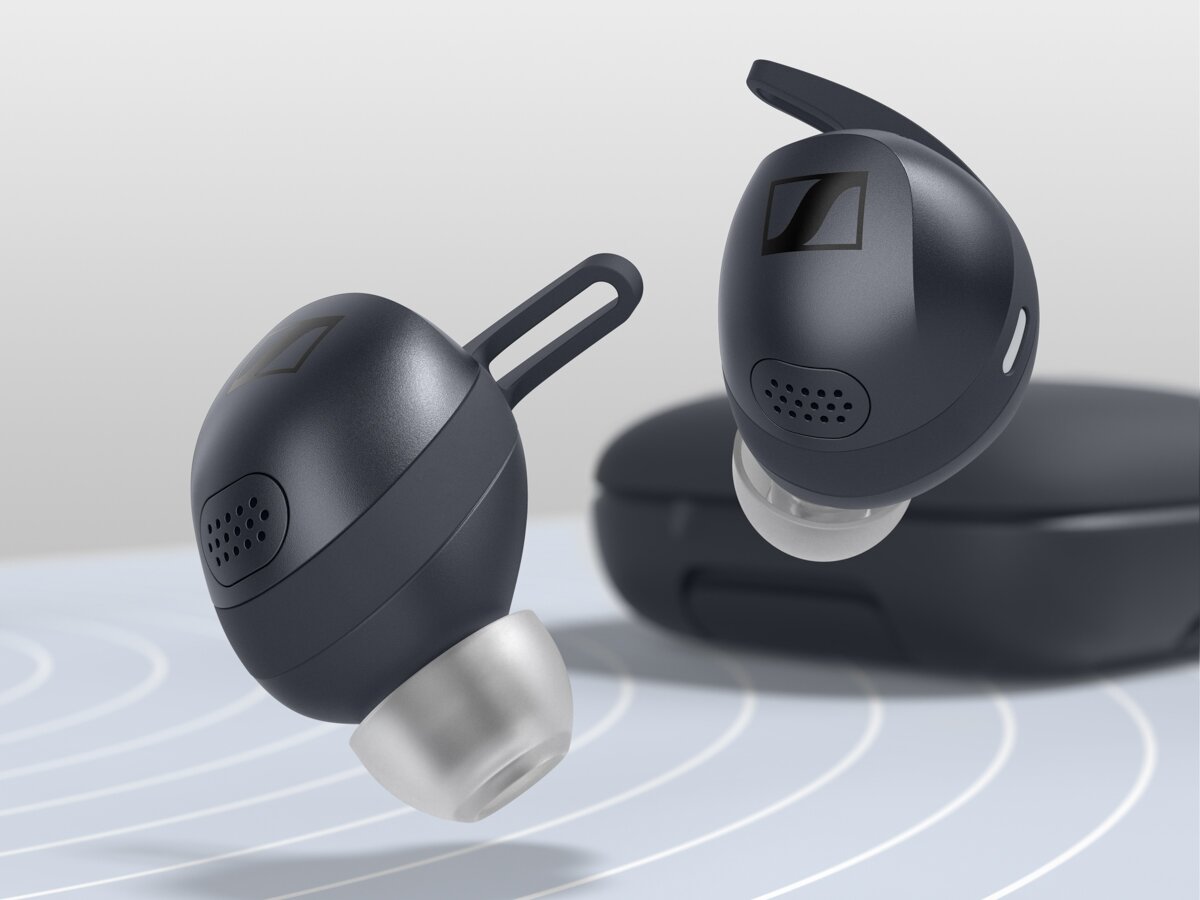
Sennheiser Momentum Sport True Wireless
Sound Signature: Impactful Bass, Clear Highs
Your wireless companion for listening on the go, the Sennheiser Momentum Sport True Wireless is designed for the athletic audiophile. Whether you're pushing the boundaries of your endurance or refining your athletic prowess, the Momentum Sport is meticulously crafted to enhance your performance and unleash your full potential. Step into a new era of sports earbuds that go beyond the ordinary, redefining excellence with unparalleled Sennheiser sound quality. With the Momentum Sport, you're immersed in a world of crystal-clear audio, powerful bass, and crisp highs, transforming your workout into an electrifying experience.
The Momentum Sport boasts a secure fit that feels tailor-made for your ears, ensuring they stay securely in place no matter how dynamic your movements. Say goodbye to distractions and hello to pure focus, thanks to adaptive active noise cancellation (ANC) that drowns out external disturbances, allowing you to immerse yourself fully in your training. And if that wasn't enough, the Momentum Sport is equipped with cutting-edge biometric sensors that monitor your heart rate and boy temperature with unparalleled accuracy.
Powering Your IEMs
Believe it or not, there is such a thing as too little and too much power, and dancing that line can impact your IEM performance more than you might think. If you don't provide enough sufficient power to a pair of IEMs the sound quality will fall short of what's expected. On the other end, overpowering them can damage the driver and impact your hearing. There are certainly instances where IEMs can be powered efficiently by a smartphone, but it's not something we recommend (unless you have absolutely no other option). You would be doing your IEMs and your ears a disservice by using your smartphone. Here are our recommendations for portable power.
Portable Headphone Amplifiers/DACs
Just because you can power your IEMs with only your phone doesn't mean you should. In the case where using your smartphone is the only option, we recommend at least pairing it with a portable digital-to-analog converter (DAC)/headphone amplifier combo. Adding a DAC/amplifier to your phone will give you more power, clarity, and detail out of your music. And in the case where your IEMs require more power than what your smartphone provides, it'll solve that problem too.
We recommend portable DAC/Amp combo units that are USB dongles. They're the easiest option to carry around that won't take up much real estate in your pockets. Most of these USB dongle DACs will require a wired connection–the best connection–but there are a few wireless options that aren't half bad either.
Digital Audio Players (DAPs)
DAPs are the real deal for your IEMs. An all-in-one unit that's basically an iPod on steroids, DAPs have a built-in DAC, headphone amplifier, Wi-Fi, and headphone jacks. A portable DAP is a great streamlined way to enjoy high-resolution audio on the go. You'll get storage for your digital music files plus, with Wi-Fi, you can enjoy content from your favorite music streaming services.
A DAP will eliminate the need for your phone and extra cables so you can listen portably with your DAP, IEM, and IEM cable—that's it! The other great thing about DAPs is that you can use them with your headphones too.
Dragon Audio Cables
Of course, your universal or custom IEMs are going to come with a stock cable from the manufacturer–maybe multiple. And the vast majority of the time, the stock IEM cable is going to do the trick, providing you with a perfectly acceptable listening experience. However, if you are left wanting something more from your IEMs, you may want to think about a cable upgrade.
Why Upgrade? Stock IEM cables, are well, stock cables. Mass-produced and oftentimes the last link in the manufacturing chain, stock IEM cables can be made with poor geometries and materials that won't enhance the sound quality. At Moon Audio, cables are what we do, and we have spent years studying and perfecting the art and science of cable making. Using the purest UP-OCC copper and silver with 7N purity 99.99998 percent, we handcraft IEM cables to help you achieve the level of clarity, detail, warmth, or immersion that you desire from your listening experience.
Our Dragon IEM Cables will bring out more of what you love in your music. We offer three Dragon Audio Cable lines for IEMs–Silver Dragon, Bronze Dragon, and Black Dragon–available in 2-pin, 4-pin, or MMCX connections. Each of these lines has its unique sound signatures that will alter the tonality of your IEMs. You can add more bass, tighten up the low-end, add resolution and detail–the configurations are endless.
Dragon IEM Cables: How to Pick the Best Cable for Your IEMs
Upgrade your IEMs sound with one of Moon Audio's Dragon Audio Cables. IEM Cables for your 2-pin, 4-pin & MMCX Connections
Verdict
The world of In-Ear Monitors offers a vast array of options to suit every listener's needs and preferences. From budget-friendly models like the Meze Audio Alba to high-end custom fits like the Empire Ears Legend X, IEMs have revolutionized personal audio experiences for musicians, audiophiles, and music lovers alike. As technology continues to advance, we can expect even more innovations in driver designs, materials, and wireless capabilities. Remember, the perfect IEM for you is one that not only delivers outstanding sound quality but also provides comfort for extended listening sessions. Whether you're a performer seeking accurate stage monitoring, a commuter looking for immersive music on the go, or an audio enthusiast chasing the ultimate in portable fidelity, there's an IEM out there waiting to transform your listening experience.
Once you find that perfect IEM, consider upgrading the stock cable to a Dragon Audio Cable. Choose from our Silver Dragon, Bronze Dragon, and Black Dragon sound signatures and alter the tonality of your favorite IEMs to suit your musical tastes. Our cables will extend the lifetime of your IEMs so you can listen to them longer and rediscover your favorite songs in breathtaking fidelity.
Related Videos
Astell&Kern + Empire Ears NOVUS IEMs: Unboxing, Comparison & Review
Custom Dragon IEM Cables: Everything You Need to Know
Dragon MMCX IEM Cables: Everything You Need to Know




